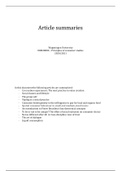Samenvatting
Summary Social cognition and affect - lecture notes
Dit is een document met uitgebreide aantekeningen van alle hoorcolleges voor het vak Social cognition and affect aan de Rijksuniversiteit Groningen. Dit bestand is een goede aanvulling op het bestand met de samenvattingen van het boek, maar het bestand kan op zichzelf natuurlijk ook goed helpen met...
[Meer zien]













